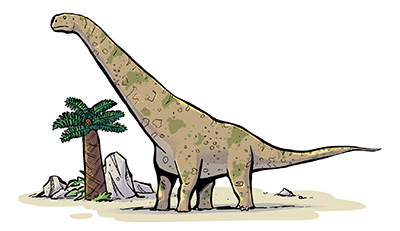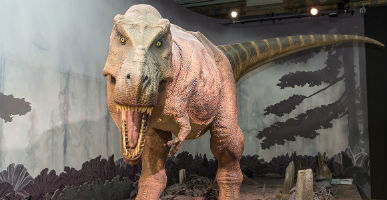Dreadnoughtus
Dreadnoughtus
- Pronunciation:
- dred-NAW-tus
- Name meaning:
- 'fears nothing'


- Type of dinosaur:
- sauropod
- Length:
- 26.0m
- Diet:
- herbivorous
- How it moved:
- on four legs
- When it lived:
- Late Cretaceous, 76-70 million years ago
- Found in:
- Argentina
Dreadnoughtus was a giant sauropod, a member of the group called titanosaurs. It lived in South America during the Cretaceous Period.
Many titanosaurs are known from only a few bones, but scientists have found around half of the skeleton of Dreadnoughtus. This means it is better understood than some of the other giant sauropods of the time. The skull has never been found though.
How big was Dreadnoughtus?
Thanks to having a good amount of fossil material to study, experts have been able to estimate the weight of this enormous dinosaur.
A calculation published in 2020 puts the animal's weight at around 48 metric tons. That's about the same as eight African elephants! However, depending on the method used, estimates have ranged from 22 tonnes to 59 tonnes.
The remains of only two Dreadnoughtus specimens have ever been uncovered. Scientists found that the largest one wasn't even fully grown. This means that nobody knows for sure how big this dinosaur could really get.
The name Dreadnoughtus means 'fears nothing', because its enormous size would have made it difficult for predators to attack. It is also a reference to the dreadnoughts - huge battleships that fought in wars of the early twentieth century.
How much did Dreadnoughtus eat?
Dreadnoughtus was so huge that it would have had to eat nearly constantly and spend as little energy as possible in order to survive.
The dinosaur's long neck meant that it would have been able to reach a large variety of plant food sources without moving its body too much. This way, it would have been able to eat vast amounts without burning too many calories.
Was Dreadnoughtus the largest dinosaur?
The biggest Dreadnoughtus specimen ever found was not fully grown when it died, so scientists can't say for sure how large this dinosaur could grow in adulthood.
As far as anyone can tell, some other huge titanosaurs, such as Patagotitan and Argentinosaurus, may have been bigger than Dreadnoughtus.
Did Dreadnoughtus really have air sacs?
Dreadnoughtus features in the Apple TV+ documentary, Prehistoric Planet. In this show, the dinosaur can be seen with inflatable air sacs on its neck.
While there is no fossil evidence to show that Dreadnoughtus really had visible air sacs, all sauropod dinosaurs had internal air sacs. These made the enormous animals lighter than they would otherwise have been.
There is no doubt that many dinosaurs would have had surprising external soft tissue features. These features rarely get preserved as fossils - so for now, we can only guess at the unusual features that Dreadnoughtus might have had.
Taxonomic details
- Taxonomy:
- Dinosauria, Saurischia, Sauropodomorpha, Sauropoda, Eusauropoda, Neosauropoda, Macronaria, Camarasauromorpha, Titanosauriformes, Titanosauria
- Named by:
- Lacovara and colleagues (2014)
- Type species:
- schrani

Step back in time
Find out more about dinosaurs' lives and the world they lived in.

Fun and games
Learn more about dinosaurs through toys, board games and activity kits, available from our online shop.

Dinosaurs gallery
Roarrr. Come face-to-face with some of the Museum's most famous dinosaurs.




